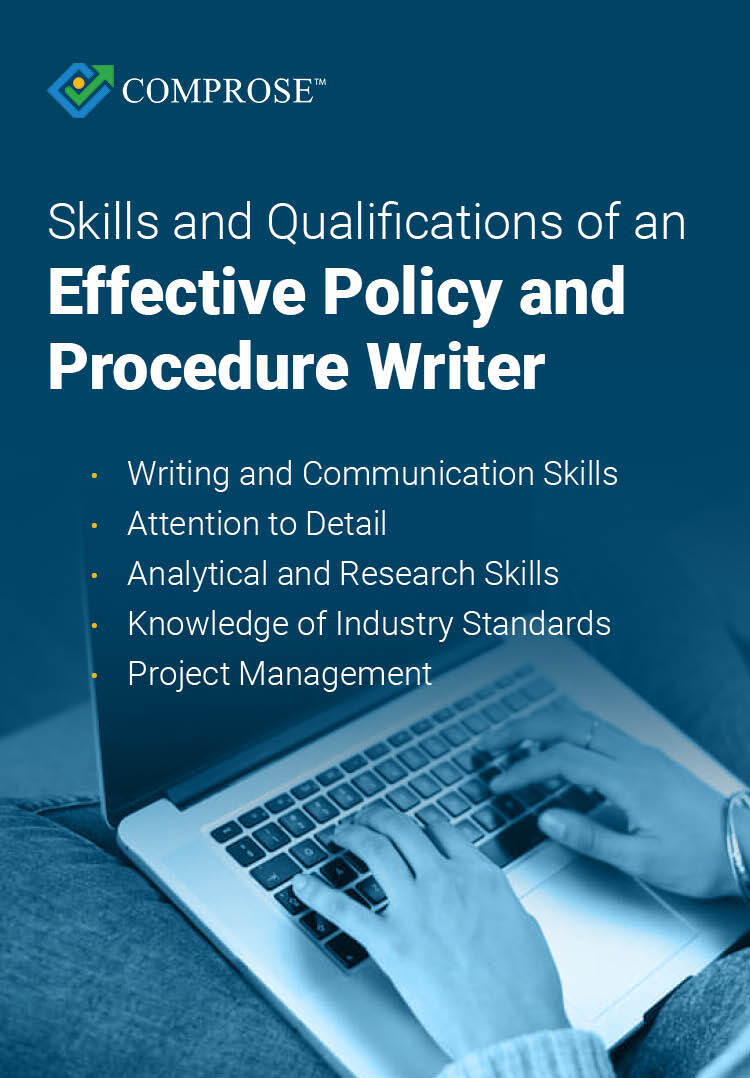
In our client’s organizations – and in our own organization – policy and procedure development is a collaborative effort. Rarely is there one policy and procedure writer in the entire organization. How this is handled is crucial for organizational success and compliance.
Policies and procedures are of little value unless they are used and followed. The quality of your policy and procedure content must be a priority.
Skills and Qualifications of an Effective Policy and Procedure Writer
It’s important to establish a point person in your organization who collects topic ideas and manages the entire process of writing standard operating procedures.
In many organizations, this may be handled at a department level, but because some processes span across different departments, it’s best to have someone oversee the entire process.
Some skills we recommend you look for include:
- Writing and Communication Skills: There is a need for strong writing abilities and clear communication.
- Attention to Detail: Importance of precision and thoroughness in this role.
- Analytical and Research Skills: Strong research and analytical capabilities to understand regulations and best practices.
- Knowledge of Industry Standards: Being knowledgeable about relevant laws, regulations, and industry standards.
- Project Management: More than just writing – but the writers must also be skilled in project management. Ensuring deadlines are met, following up with reviewers, and collaborating with stakeholders are all necessary parts of creating policies and procedures that require project management skills.

Understanding the Role of a Policy and Procedure Writer
Writing is more than grammar or wordsmithing. Writing plays a critical role in several stages of the policy and procedure management process:
- Planning
- Creating the initial draft
- Editing and ongoing maintenance
Planning
Start by asking: Is a new policy or procedure needed? If so, why do we need it?
Who decides?
Often, it’s a manager or someone who supervises a team. Managers are also in a good position to know what’s going on in the organization and if a policy, process, or procedure is needed to address an issue or avoid a serious mishap. And obviously if your organization is heavily regulated, there will be policies and procedures you must have.
Before you do anything, make sure the policy or procedure doesn’t already exist or isn’t already documented in some way. That’s why it’s so important to have a centralized system that makes it quick and easy to see if someone already wrote a policy or procedure on the topic or if related information already exists.
We can’t tell you how many times we’ve spoken to organizations frustrated after they’ve spent hours and hours on content someone else has already written! This happens even in the smallest of companies.
Creating the initial draft
We recommend considering what we call the “SME model.” Give your subject matter experts a structured interviewing tool so they can develop the initial content. At a minimum, involve them directly and early on.
A manager may be best equipped to write policies. For processes, procedures, and work instructions, your expert or someone who has done the job is best equipped to write the initial draft.
We’ve heard all the excuses. “Our experts don’t have time” or “Our people are too highly paid to spend their time formatting documents.”
Considering that most people use cumbersome, labor-intensive tools for the job, this reaction is perfectly understandable. If you are using a general-purpose tool like MS Word, the formatting alone takes up to 60% of the time creating the initial draft.
Give subject matter experts the right tool so that they easily share important information and lessons learned. After all, they understand the audience better than anyone else and can make good policies and procedures that your people will use.
Editing and ongoing maintenance
Writing doesn’t stop once the initial draft is created.
In most organizations, the initial policy or procedure draft is sent on to a review team. Then, the document may be edited further based on your review team’s comments. After final approval, the document is published. If you use a specialized policy and procedure system like Zavanta, much of this process is automated.
If a policy or procedure needs updating, the SME may be called in again.
Unfortunately, far too many organizations call it a day once the initial version of a policy or procedure is published. They fail to recognize that this is a continuous improvement task. As operations change, the policies and procedures need to reflect those changes.
While in a meeting with a client, we observed first-hand the havoc outdated procedures can have on an organization when the manager said “No wonder people are confused. We don’t do it like this anymore.” The process document was never updated when the actual process changed.
Involving Subject Matter Experts at the Beginning Reduces Overall Costs
It’s more efficient. It also leads to shorter review cycles.
Think about how many times a day your experts get interrupted by people asking them for help. If your procedures are incomplete, vague, or inaccurate, your subject experts will spend a lot of time anyway — answering routine questions, fixing peoples’ mistakes, or putting out fires. How would you rather they spend their time? People are often astounded at the amount of freed-up time they gain by taking time upfront to transfer their expertise and lessons learned.
Consider how most organizations capture knowledge. Someone either guesses the procedure or the subject expert dictates the procedure to someone who then writes it up. Then that person must repeatedly go back to the subject experts and get them to review the write-ups, validate accuracy, and plug in the inevitable holes.
Even if the expert does invest the necessary review time, the holes may never get plugged. It’s easy to see how this development method and approval process is inefficient, impractical, and error prone.
We recently talked to a manufacturing firm whose management thought that their SOP and checklist writing problem was solved after they added a tech pubs group. Although the technical writers were experts at their craft, SOP users found the SOPs cumbersome and missing critical details because the writers didn’t involve their process engineers early on. The back and forth was expensive and risky.
By involving the people who know and perform the work, you have a built-in system for re-evaluating processes and continuously improving processes.
In our experience working with hundreds of organizations, at this stage its optimal to have a writer who has these attributes:
- They know the ins and outs of the job.
- They have a process or systems background.
- They are familiar with industry standards.
Guided Authoring makes the writing process simple
A knowledge of writing best practices is always a plus. We’re firm believers in the power of effective communication. Ensuring that employees have good writing skills helps them in all aspects of their job.
But if you utilize a system like Zavanta that has Guided Authoring built in, even a novice writer can create standardized, usable policy and procedure documents. Guided Authoring prompts the authors for all the information, in the right order, and handles all the formatting, giving authors clear guidelines that will result in high-quality documentation (to learn how this works, check out our demo).
Collaboration Between Policy and Procedure Writers is Best
After the initial draft is created, someone skilled at writing can always check and edit the initial draft if needed.
And typically, there are others in the organization that need to be consulted. Critical procedures need to be tested by someone other than the author. Below are common examples:
- The marketing department may provide support to HR when crafting a company social media policy.
- A Chief Safety Officer may set safety policies but needs frontline workers’ input on procedures.
- An HR professional may write the draft for "Privacy Policy" or “Code of Conduct,” but representatives from legal and risk management need to weigh in.
- The IT security expert writes the initial Employee Security Policy draft, and selected employees give their feedback.
The Impact of Policy and Procedure Writers on the Organization
The #1 requirement we hear the most is that organizations want their employees to use and follow policies and procedures.
Obviously, people need to be able to find what they need, when they need it. But it’s what they find that makes the biggest impact. It’s the content inside of documents that enables your teams to take the right action and respond quickly when something goes wrong.
Far too often, policies and procedures don’t get used or cause people to make mistakes because the information in them is confusing, incomplete, and often out of date. One organization we talked to told us how they spent $1M on a SharePoint system that was abandoned due to lack of use.
If policies and procedures aren’t used, you open yourself up to serious problems, liability, failed audits, and unnecessary operational costs.
This is why policy and procedure writing is important. It impacts the overall success of an organization.
In addition to aiding the end user, well-written, standardized content provides other benefits:
- Operational Efficiency: Clear policies and procedures streamline operations and reduce confusion.
- Compliance and Risk Management: Well-documented policies ensure regulatory compliance and mitigate risks.
- Employee Guidance and Support: Policies and procedures provide employees with clear guidance and support, reducing errors and enhancing performance.
- Consistency and Quality Control: Standardized procedures maintain consistency and high quality across the organization.
Zavanta is Designed to Help the Policy and Procedure Writers in Your Organization
With Zavanta, our goal is to help any business professional create user-focused, audit-ready policies and procedures. And enable them to do it faster by eliminating time consuming formatting.
This approach was and still is a breakthrough over conventional word processing approaches.
Our first user, a chemist, was overwhelmed with having to write SOPs for FDA compliance. He was a subject expert, not a writer. With our software, he was able to generate his first user-friendly procedure in minutes.
Since then, we’ve added features to address other challenges: scalability, document control, review approval workflows, updating, translation, attestation, and implementation. Zavanta has evolved into an end-to-end policy management solution that streamlines every part of the policy and procedure management process.
Contact our team to learn more.
Additional Resources:

